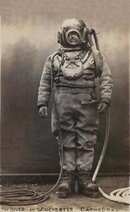I did a lot of diving with marine biologists in the 1960s. One was also a NAUI instructor. Nobody even tough to avoid touching the bottom, but we all avoided landing on soft critters like anemones and nudibranchs. With the exception of relatively rare Hydro Coral, the sea life isnt nearly as delicate or slow-growing on Californias Coast as Floridas though. Kelp grows about 18"/day, dies off, and re-grows every year.
I see the bottom kicked up by new divers a lot more now because so many are terribly over-weighted. I cant remember the last time I saw a new-school diver swim to the bottom instead of pushing the down-button on their BC. With rare exception, they are also really ignorant of diving physics and physiology. The majority are also terrible swimmers and have no idea how to freedive or execute a self-rescue from the bottom.





